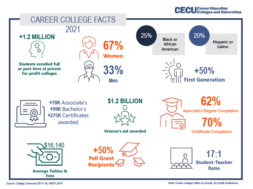
Workforce Analytics Help Schools to Build Curriculum, Student Skills
Written from an Interview with Jim Milton, Chief Executive Officer, Campus Management Corp.
Unless you have a crystal ball, it’s difficult to predict what jobs might be created five, 10 or 20 years from now. Transforming student success through workforce analytics can help to assure that graduates’ skillsets match employer expectations, said Jim Milton, CEO of Campus Management Corp., a provider of student information systems (SIS) and customer relationship management (CRM) solutions to higher education institutions.
According to Jim, by partnering with real-time job analytics companies, they know that about 6 million jobs are available, plus the skills that are needed for those 6 million jobs.
By looking at the statistics over time, however, they can see trends and predict how those skills will evolve and change.
“Real-time job analytics companies aggregate many different data sources, and then parse that data down into skills,” he said. “For instance, using this data, we’ve noticed that many of those 6 million jobs were in sales, although few colleges or universities offer classes in sales.”
“Sales is a skill that can be taught,” Milton said. “There are elements that break down the selling process. How do I qualify a prospect if it’s business-to-business as opposed to business-to-consumer? How do I close? What are the influencing skills? These are all things that can be taught.”
“So if you are selling pharmaceutical or medical equipment and working toward earning a certificate or associate’s degree in a medical program, you are going to be better equipped, particularly if you can complement those skills with basic sales knowledge,” he said.
Real-time job analytics not only helps them give timely insight into the expertise employers are looking for in specifics jobs and career field, but it also provides students with relevant salary information and designs academic programs using an inventory of skills that employers are looking for in that field.
Milton said using data to predict job trends is important for career schools. “I credit a lot of the success of Campus Management to the fact that we have been working within the sector for several decades. We’ve had to stay one step ahead, and we continue to bring innovation to the table. In fact, online education was mainstreamed, if not invented, within the career education sector,” he said. “Now competency-based education models are being driven from this sector, and we have an opportunity to really move forward at a rapid pace.”
Their partnership with Burning Glass, a cloud service provider that aggregates job data from multiple resources, allows Campus Management to take job skills data, in real time, and combine it with institutional data or an individual student path. The result is visualized in a dashboard that shows the highly relevant data in graphs and maps. “Imagine a scenario where I’m considering a nursing program, and I’m checking out your institution,” he said. “I go to your website because I see that you offer a nursing program.”
The website identifies where users are by using geo-location. “So if you’re living in Phoenix and looking at nursing programs, the website will pop up that there are 782 jobs in the Phoenix area today for nurses with an average starting salary of $48,600 a year, and then tells you to ‘click here’ to enroll,” Milton said.
The data can also be used to retain students, he said. Imagine that a student is going through your nursing program and something triggered an attrition risk such as a transcript request. You bring in a counselor to sit down and talk with the student and ask about his or her experience.
“The student says, ‘I’m not sure I want to stay in the nursing program,’ or ‘I’m considering changing institutions,’” Milton said. “That’s where we can provide that same data to the counselor to say that there are 782 jobs today available … and the starting salary is $48,600. Why don’t we talk about how we can get you back on track and stay focused?”
Milton said they are currently working on a finer grained mapping of skills needed for a particular job or career to how customers can design their curricula.
In their Career Services’ software, they can break down curriculum into skills, which allows for competency-based education and assessment-based training.
“To use a simple example, if one of my courses is for a network systems engineer, I know that 80 percent of the jobs for network systems engineers that are open across the United States require Cisco certification,” he said. “I’d want to make sure that my course curriculum includes Cisco certification, or the skills necessary to achieve a Cisco certification. Therefore, I’m aligning those skills that I’m teaching in the course to the skills that are on the job market.”
The next step will be giving students the ability to populate their LinkedIn profile with the type of skills they acquire as they go through their academic program. “We’re working with our customers and partners on everything I’ve just described. We’re tackling real-time data alignment with our CampusNexus software and its ability to tackle specific issues like helping with retention and recruiting.”
Milton said Campus Management has a strategic partnership with Microsoft, which now owns LinkedIn. “That allows us to start to get down into the real architectural challenges and how to leverage LinkedIn, for example,” he said. “We’re also working with them to integrate Microsoft services like machine learning, and how to build more analytics and individualized education so that we meet the unique needs and requirements of specific students.”
The challenge becomes how to mainstream that, he said. “How do I bring that to my client base and deliver real value?”
Milton said it is a constant challenge to get schools to adopt new technology at scale, even though their customers – students – tend to embrace new technology more than other sectors. “But it’s imperative now, not just within administrative systems but also broadly in colleges and universities, to transform or perish because of declining enrollments, competition for the same student and the rise of student debt. All of those things are putting pressure on institutions to leverage technology and innovation at a pace that they have not before.”
There is no doubt that times are changing and several challenges are facing U.S. higher education institutions. But the biggest challenge is declining enrollments of about 1 ½ percent per year since 2010, Milton said.
Another challenge surrounds regulation. “It’s not just the amount of regulations that exist and the need to stay compliant, but it’s that the regulations change all the time,” Milton said. He said Campus Management devotes a significant percentage of their development and product management teams to tracking regulations at both the state and federal levels at all times. “They have to adapt our software to allow the institutions to be compliant,” he said. Sometimes, changes will need to be implemented in weeks. “It’s a fact that these regulations are constantly changing or being clarified, and the extra cost to the institution to manage the process is something I hear amongst our client base,” Milton said.
Another challenge is the rising competition among colleges for the same student. “Students have a lot more choices today, particularly as you look at the pervasiveness of online education,” Milton said.
“It’s not just community driven anymore. That competition for the same student is putting a lot of pressure on institutions to work on their brand so they stand out from the crowd.”
For instance, mission-focused career-oriented schools that offer online programs might compete for students with Southern New Hampshire University, Arizona State University, Grand Canyon University, University of Phoenix, and others, he said. “Many of those institutions advertise on television. They make effective use of social media. If I’m a smaller institution, my brand has to stand out from folks that have a heck of a lot more money to spend on marketing than I do.”
But Milton predicts that career schools will stand out since they are positioned to help fill the skills gap efficiently, often at a much better price point. Career Education Colleges and Universities, the association that represents career schools, has a mission to create 5 million, well-trained and well-skilled graduates over the next decade. But Milton predicts that they’ll do better than that.
“It’s a big challenge because not only do you have to understand what the gaps are today in the 5 million or 6 million jobs that are now open in the United States, but you also have to understand why those gaps are there and what skills are needed in a graduate from a certification program or a diploma program, to fill those gaps,” he said.
Just as importantly, you have to understand what those gaps might look like five years from now. Milton cited cybersecurity as an example.
“Cybersecurity didn’t exist eight or 10 years ago,” he said. “But now there is a huge requirement for people who have cybersecurity skills, and they don’t need to have a doctorate in the field. In a large corporation, they may have someone who has a Ph.D. in charge of cybersecurity, but they also may have 50 or 100 people supporting that person with a doctorate, including those who just have certification.”
Another example is robotics, which is a field that is hard to predict, he said. “There’s a lot more that has to be done around curriculum design, and around ensuring that students get the latest and greatest certificates, whether they’re in a two-year program, a four-year program, or a certificate program, to ensure that they’re employable when they’re ready to jump into the job market,” Milton said. “We need to keep progressing with flexible curriculum models and the ability to add credentials and skills that are going to be in demand tomorrow.”
Milton said Campus Management is tackling that problem with its software and with partnerships, such as with Burning Glass and Microsoft.
In June, President Donald Trump signed an executive order that calls for the expansion of apprenticeships and more support for institutions that infuse apprenticeships into their coursework. But Milton said it’s too early to say how that will impact the sector. “My assessment is that it’s only going to be a positive for the sector, but how it translates into an opportunity for the sector is still to be determined,” he said.
Some of the leading institutions within the sector have really innovated in the area of partnering with employers, he said, and if you extend that into an apprenticeship-like model, those institutions are already fairly close. “This could make vocational training cool again.”
But one of the biggest problems will be parents, he said. “If mom and dad came out of a four-year-traditional school, they assume their child will go to a four-year school just like they did,” Milton said. “Broadly speaking, vocational education and technical or career training has been looked down upon. But a lot of jobs that are open today are middle-skill jobs. We really need to reconsider how we’re guiding future students … and help them choose a career and institution that makes sense for them.”
Today, 78 percent of those jobs require digital skills, while digitally intensive jobs are growing twice as fast as other middle-skill jobs, and are twice as likely to pay a living wage.
Operational efficiency is crucial to scaling up these programs in the current budget climate. “We’re focused on adding more and more automation around financial aid so you can be more efficient with your people,” he said. “We’re focusing on the extension of our software through the use of workflow, which allows you to configure it to the unique needs of an institution. Campus Management is ensuring that we really help institutions be more flexible and adaptable and operationally efficient through a Cloud deployment model.”
A Cloud deployment eliminates waste or inefficient use of time, Milton said, and allows the IT staff to be focused on solving business problems, dealing with the various departments and acting more like analysts rather than IT infrastructure people. “The security of the Microsoft Azure Cloud, managed by a higher ed focused company like Campus Management, is far greater than a company, or a college or university, could do on their own,” Milton said. “They can really scale up in terms of security and disaster recovery.” Currently, about one-third of their 450 customers worldwide are deployed in the Cloud, he said, and 34 of their FY2016 clients in the U.S. selected the cloud solution.
JIM MILTON has more than 30 years of sales, marketing, general management and CEO leadership experience. He currently is chief executive officer of Campus Management Corp., a leading provider of cloud solutions and services that help to transform higher education institutions. Its next-generation suite, CampusNexus, includes enterprise-wide student, customer relationship management and finance, HR and payroll solutions. Today, more than 2,000 campuses in 20 countries partner with Campus Management to transform academic delivery, student success and operational efficiency.
Before taking over at Campus Management Corp. in August 2014, Milton was president and CEO of SoundBite Communications, a SaaS/Cloud-provider of multi-channel communication solutions. During his tenure there, he transformed and expanded the company’s product offerings, orchestrated and integrated two acquisitions, and directed its ultimate sale to Genesys in 2013.
Milton has also held senior executive roles at organizations that include Intervoice, now part of Convergys; UGS, now part of Siemens; Digital Equipment Corp.; Compaq Computer Corp. and Hewlett-Packard Co.
He graduated from the University of Waterloo, Canada, in 1983 with a bachelor’s degree in mathematics, and joint honors in computer science and economics.
Contact Information: Jim Milton // Chief Executive Officer // Campus Management Corp. // 5201 Congress Ave. // Boca Raton, FL 33487 // 561-923-2500 // https://www.campusmanagement.com // LinkedIn profile











